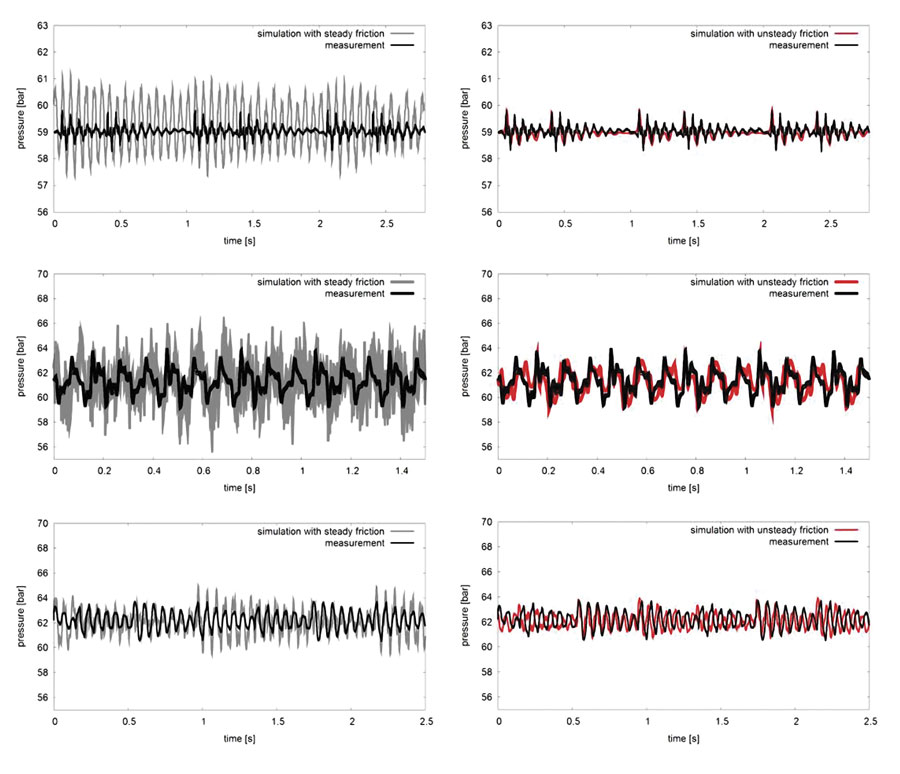Synchronization of several pumps is an effective way to reduce pressure pulsations and vibrations in the pipelines. In part 1 of this series, we explored how Lewa has developed a powerful CFD software module for making accurate statements about dynamic processes or pressure amplitudes and properly dimensioning the entire system. In part 2, we will compare the simulation results with the measurement to seek a clearer understanding of the benefits available by employing this precise tool.
TWO CLASSES OF FRICTION MODELS
In general, there are two distinct classes of friction models that can be used in one-dimensional CFD calculations. Instationary models incorporate a flow profile that changes over time. Stationary models, by contrast, do not. In many applications, flow rate does not change at all or changes only very slowly, such as systems with centrifugal pumps. Stationary friction models are suitable for these situations.
“But when reciprocating positive displacement pumps are used, flow rate typically changes very rapidly and very significantly, so a fully developed flow profile never arises in the pipeline, according to Marco Klinkigt, physicist at LEWA´s Technical Product Management department.
“In these cases, it is essential that we take the rapid changes to the flow profile into consideration,” he continues. “However, implementing the model requires a much greater effort and significantly longer calculation times. “To the best of our knowledge, there are no commercially available one-dimensional CFD software programs that implement a comparable model.”
Lewa has validated the new CFD module with both stationary and instationary friction models. The stationary model was additionally checked against a commercial software solution. The results of the Lewa software matched the results of the third-party software. Then both fiction models were put onto the experimental test center to show how well they can reproduce the actual measurement results.
EXCESSIVE “PEAK TO PEAK” PRESSURE PULSATION AND FALSE FADING BEHAVIOR
The comparison between the measurement series clearly shows that the instationary friction model has quantitatively and qualitatively better congruence with the measurement results, whereby two things are most apparent: When the stationary friction model was used, the value of the peak-to-peak pressure pulsation (pmax[t] – pmin[t]) was too large in virtually every observed case. In some cases, a deviation of greater than 200 percent was observed.
“Using this kind of model during the design phase can sometimes lead to the selection of inefficiently large dampers or resonators and the installation of unnecessary orifices in the pipes,” says Marco Klinkigt.

Comparison of the simulation results with the measurement clearly shows the superiority of the instationary friction model: On the left side, the black line represents the results of the measurement, while the gray line represents the simulation results with the stationary friction model. At the right, the black line represents the measurement results while the red line represents the simulations results with the instationary friction model. The first pump runs at 60 spm in a double configuration. In the second example, there is a single pump-head configuration that runs at 200 spm. In the third case, the pump runs at 50 spm in a triplex configuration.
Another significant difference between the simulation results is the fade behavior of the initial pressure peaks during connection. Due to the compressibility of the fluid, the valves at the pump head open with a certain delay. And once the valves are finally open, the piston is already in movement. As result, the connection between the fluid in the line and the fluid in the pump head can be very hard and lead to initial pressure peaks. The simulation with the instationary friction model reproduces virtually the same fade behavior as the measurement results. The stationary friction model exhibits fade behavior that is much too slow.
While the stationary friction model exhibited much poorer congruence in many test measurements, the simulation results with the instationary friction model corresponded very well with the measurement values. So Marco Klinkigt’s opinion can be summed up as follows: “Instationary friction models in one-dimensional CFD calculations exhibit very good congruence with the measurement results and help avoid the use of unnecessary, inefficient, or redundant measures intended to reduce pressure pulsation.”
NEXT STEPS IN THE PLANNING
The most recent results confirm the company’s strategic alignment. The Lewa mission is to continually advance in the interests of its customers, which is why they not only use cutting-edge tools and processes, but also make every effort to continually improve their equipment and methods. In the near future, Lewa will focus on optimizing simulation models of various damper devices like bladder accumulators, air chambers, and resonators. In a second step, the simulation of the mechanical reaction of the piping elements and fittings due to pressure pulsations will be examined and optimized. Based on the simulation results, Lewa will then have the ability to additionally optimize the mechanical mounting aspect of the pipeline system. Proper dimensioning and positioning of piping fasteners reduces investment costs and contributes to the overall system’s longevity and reliability. ◆
For More Information:
Stefan Glasmeyer is managing director of Lewa GmbH, the world’s leading manufacturer of metering pumps and process diaphragm pumps as well as complete metering packages for process engineering. Lewa develops technologies and provides solutions for the vast array of applications among its customers. The products see use primarily in the oil and gas industry in applications involving gas odorization, petrochemicals and in refineries as well as in the manufacturing of plastics, detergents and cleaning agents. Additional application areas include the chemical industry, cosmetics industry, pharmaceuticals and biotechnology, food and beverage industry, and power supply utilities. For more information, visit www.lewa-inc.com.
____________________________________________
MODERN PUMPING TODAY, February 2017
Did you enjoy this article?
Subscribe to the FREE Digital Edition of Modern Pumping Today Magazine!
![]()


